
The nose can be divided into three major sections:
• The upper third of the nose is made up of the nasal bones
• The middle third is occupied by the upper lateral cartilages which join the nasal septum. This septum separates the left and right nostrils.
• The lower third is occupied by the lower lateral cartilages
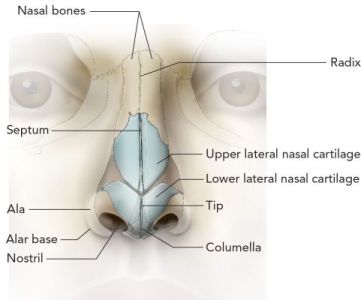
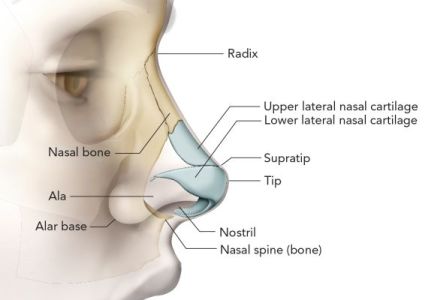
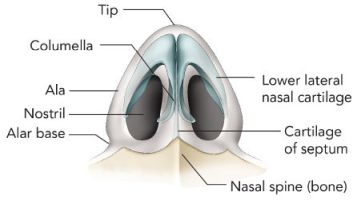
A nose that is considered ‘ideal’ is one which is harmonious with the other favorable facial features. Our perception of beauty helps define what makes an ideal shape for a female or male nose. There is also always a bit of an artistic element to this, thus the ideal cannot always be boiled down to simple lines and numbers alone. However, artists and plastic surgeons alike can devise some guidelines or proportions that represent the aesthetic ideal by studying beauty and faces that are universally thought to be beautiful. Artists have long made studies of beauty and aesthetic proportions and, today, facial plastic surgeons must similarly understand beauty in order to make changes that can enhance their patients’ beauty.
Of course, some lines, numbers and measurements do exist. Shown below are the lines and measurements that facial plastic surgeons use as a guideline to the aesthetic ideal.
Facial proportions
The “ideal” face can be divided into equal upper, middle and lower thirds at the hairline (trichion), the brow at the level of the supraorbital notch (glabella), subnasale, and mentum.
Lower third is further divide into the upper third and the lower two thirds by line between oral commissures.
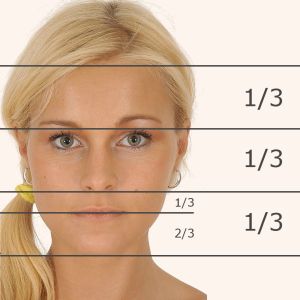
Nose Width
The “ideal” face can also be divided into equal vertical fifths. The width for the nose is equal to one eye width (intercanthal distance).
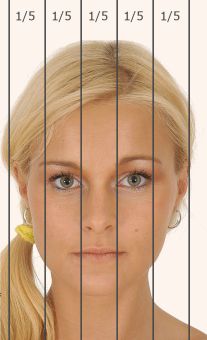
Nasal projection / Tip projection
This is the forward protrusion of nasal tip from face. The ratio of nasal length to tip projection should be 1.0 : 0.5~0.66.
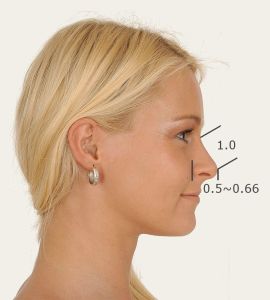
Nasolabial angle / Columellar labial angle
This is the angle defined by columellar point-to-subnasale line intercepting with subnasale-to-labrale superius line. Normally between 90°-120°, the aesthetic angle is 90°-100° for male and 95°-105° for female. An acute nasolabial angle can lead to a droopy nose, whereas an obtuse nasolabial angle can lead to a short or ‘uplifted’ appearance.
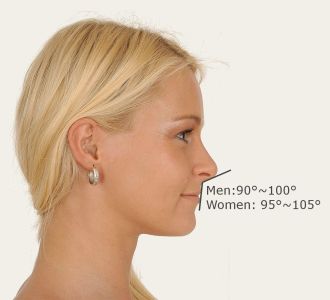
Nasofacial angle
This is the angle defined by glabella-to-pogonion line intersecting with nasion-to-tip line. Normally 30°-40°. The nasofacial angle is one way of assessing the projection of the nose from the face. The nose is likely too far from the face if the nasofacial angle is large, or the opposite may be true if the nasofacial angle is too short.
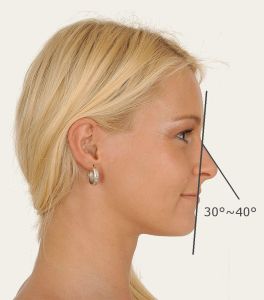
Columellar show<br />This is the alar-columellar relationship, or how much of the nostril is visible. 2-4mm of columellar show is normal. Too much or too little ‘columellar show’ is, from the side, undesirable.


If you are unhappy with the appearance of your nose, or suffer from medical issues with your nose, we invite you to contact our nose surgery service today. You can find the answers to the most frequently asked questions here. Your doctors in Korea will provide a comprehensive medical history and Rhinoplasty analysis that will allow them to provide each patient with an accurate diagnosis so that a patient-specific treatment plan can be put into action. Contact us now.

Please send us your email address, and one of our representatives will personally contact you as soon as possible.
Your email address will never be sold or spammed.